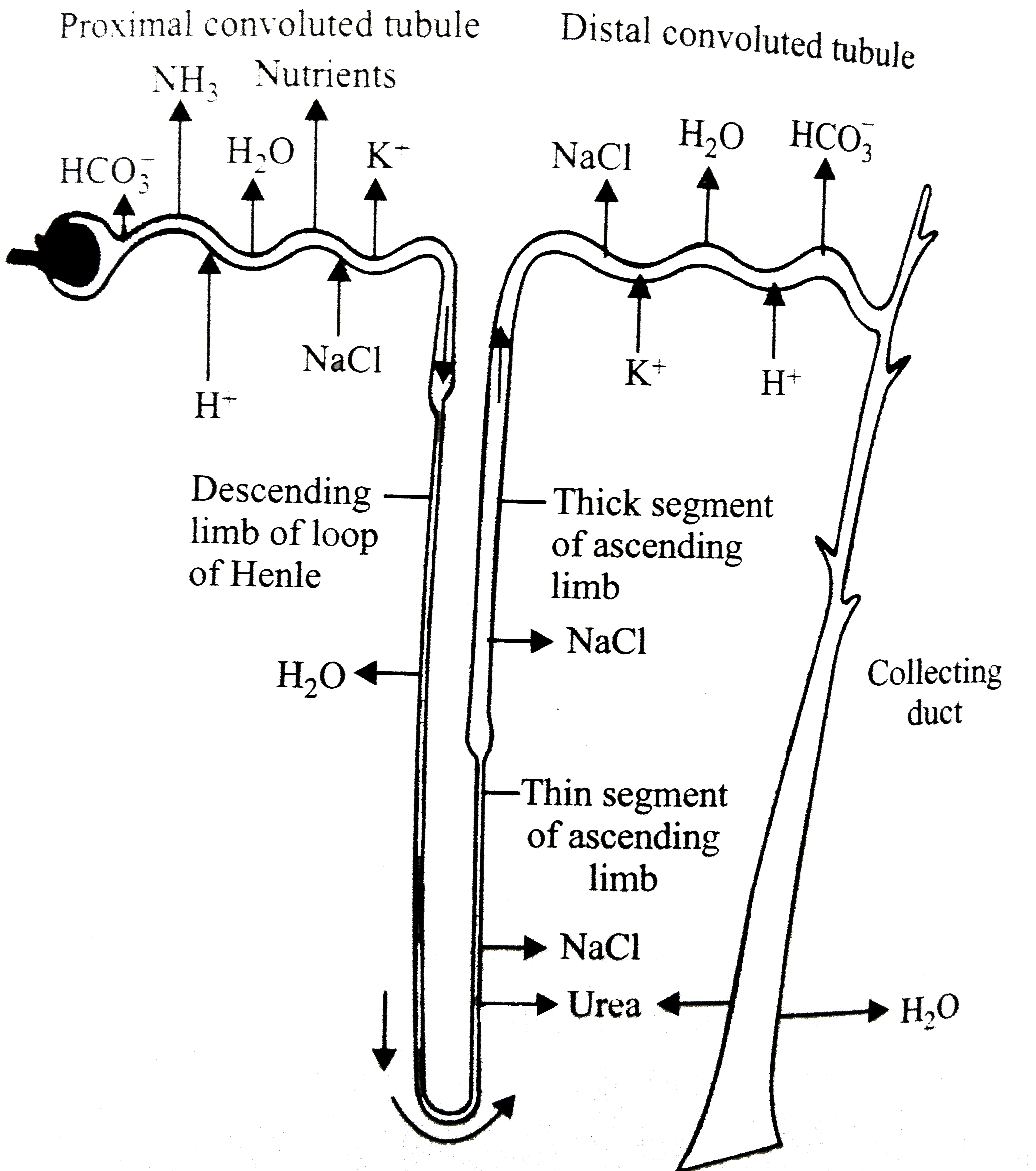A nephron's reabsorption mechanism depends on:
osmosis across nephron wall
active transport of sodium across nephron wall
a steep solute concentration gradient
all of the above
The correct Answer is:D
To answer the question regarding what a nephron's reabsorption mechanism depends on, we can break down the components involved in the reabsorption process step by step.
1. Understanding Nephron Structure:
- A nephron consists of several parts including the glomerulus, proximal convoluted tubule (PCT), loop of Henle, distal convoluted tubule (DCT), and collecting duct. Each part plays a role in the filtration and reabsorption of substances.
2. Reabsorption Mechanism:
- Reabsorption in the nephron is the process by which essential substances (like water, ions, and nutrients) are reabsorbed back into the bloodstream after being filtered out from the blood.
3. Osmosis Across Nephron Wall:
- Osmosis is the movement of water across a semipermeable membrane. In the nephron, water is reabsorbed from the filtrate back into the blood, which is crucial for maintaining fluid balance and concentration of solutes.
4. Active Transport of Sodium:
- Active transport mechanisms are used to move sodium ions (Na+) from the nephron tubules back into the blood. This process requires energy (ATP) and is vital for maintaining electrolyte balance and creating a concentration gradient.
5. Steep Solute Concentration Gradient:
- A steep concentration gradient of solutes (like sodium and chloride ions) is necessary for effective reabsorption. This gradient facilitates the movement of water and other solutes from the nephron back into the blood.
6. Conclusion:
- The nephron's reabsorption mechanism depends on all of the above factors: osmosis, active transport of sodium, and the steep solute concentration gradient. Therefore, the correct answer is option D: all of the above.
Final Answer:
The nephron's reabsorption mechanism depends on:
- A) Osmosis across nephron wall
- B) Active transport of sodium across the nephron wall
- C) Steep solute concentration gradient
- D) All of the above (Correct Answer)
- A nephron consists of several parts including the glomerulus, proximal convoluted tubule (PCT), loop of Henle, distal convoluted tubule (DCT), and collecting duct. Each part plays a role in the filtration and reabsorption of substances.
- Reabsorption in the nephron is the process by which essential substances (like water, ions, and nutrients) are reabsorbed back into the bloodstream after being filtered out from the blood.
- Osmosis is the movement of water across a semipermeable membrane. In the nephron, water is reabsorbed from the filtrate back into the blood, which is crucial for maintaining fluid balance and concentration of solutes.
- Active transport mechanisms are used to move sodium ions (Na+) from the nephron tubules back into the blood. This process requires energy (ATP) and is vital for maintaining electrolyte balance and creating a concentration gradient.
- A steep concentration gradient of solutes (like sodium and chloride ions) is necessary for effective reabsorption. This gradient facilitates the movement of water and other solutes from the nephron back into the blood.
- The nephron's reabsorption mechanism depends on all of the above factors: osmosis, active transport of sodium, and the steep solute concentration gradient. Therefore, the correct answer is option D: all of the above.
The nephron's reabsorption mechanism depends on:
- A) Osmosis across nephron wall
- B) Active transport of sodium across the nephron wall
- C) Steep solute concentration gradient
- D) All of the above (Correct Answer)
Topper's Solved these Questions
- BOOK - ICSECHAPTER - EXCRETORY PRODUCTS AND THEIR ELIMINATIONEXERCISE - TEST YOUR PROGRESS ( OBJECTIVE TYPE QUESTIONS ) (Fill in the blanks with appropriate words.)26videos
EXCRETORY PRODUCTS AND THEIR ELIMINATION
- BOOK - ICSECHAPTER - EXCRETORY PRODUCTS AND THEIR ELIMINATIONEXERCISE - TEST YOUR PROGRESS ( OBJECTIVE TYPE QUESTIONS ) (State whether the following statements are true or false .)18videos
EXCRETORY PRODUCTS AND THEIR ELIMINATION
- BOOK - ICSECHAPTER - EXCRETORY PRODUCTS AND THEIR ELIMINATIONEXERCISE - REVIEW QUESTIONS (LONG ANSWER TYPE QUESTIONS )19videos
EXCRETORY PRODUCTS AND THEIR ELIMINATION
- BOOK - ICSECHAPTER - ENZYMES EXERCISE - REVIEW QUESTIONS (LONG ANSWER TYPE QUESTIONS)6videos
ENZYMES
- BOOK - ICSECHAPTER - KINGDOM FUNGI EXERCISE - REVIEW QUESTIONS (LONG ANSWER TYPE QUESTIONS)5videos
KINGDOM FUNGI
Similar Questions
Knowledge Check
- Question 1 - Select One

The accompanying figure shows reabsorption of some constituents of glomerular filtrate in different parts of mammalian nephron. What can these constituents be?AA−Na+,B−Water,C−UreaBA-Urea, B−Na+, C-WaterCA-Water , B-Na+,C-UreaDA-Na+,B-urea, C-water - Question 2 - Select One

The given figure shows reabsorption and secretion of major substances at different parts of the nephron. The movelment of which of the following substances is wrongly depicted?ANaCl and K+ at DCTBNaCl and NH3 at PCTCNaCl at ascending limb of loop of HenleDH2O at descending limb of loop of Henle
In which segment of the nephron, reabsorption is minimum?
View SolutionIn nephron, water absorption is maximum in
View SolutionIn nephron, water absorption is maximum in
View SolutionAdjustments in sodium concentration occur at the ................. of the nephron. Reabsorption of sodium ions is controlled by the hormone ...... which is produced by the adrenal cortex.
View SolutionWhere do ultrafiltration, reabsorption and secretion occur in a nephron?
View SolutionDraw a labelled diagram showing reabsorption and secretion of major substances at different parts of the nephron.
View Solution

